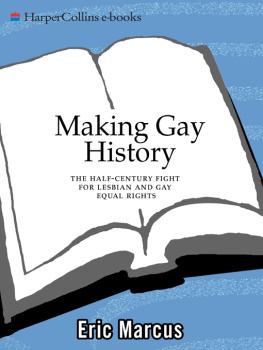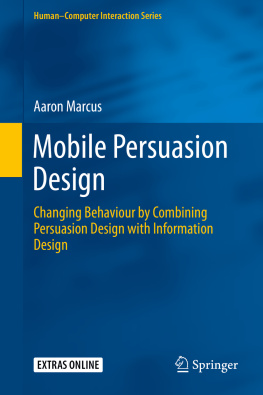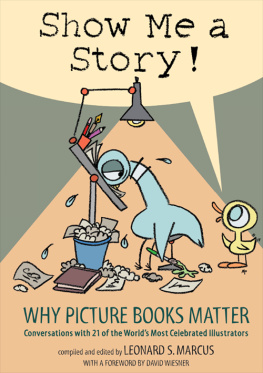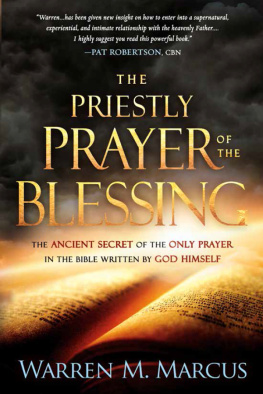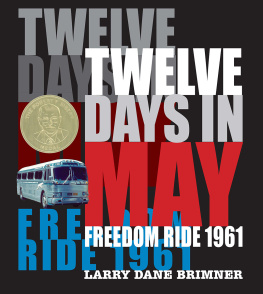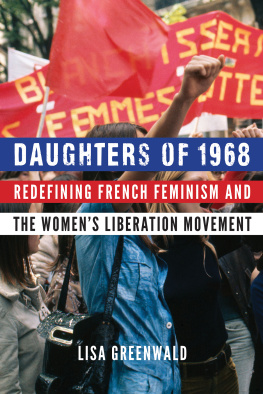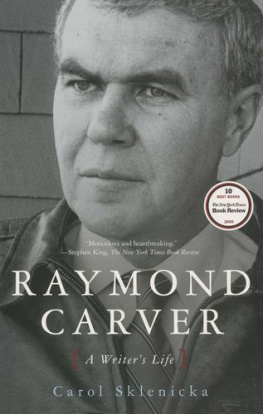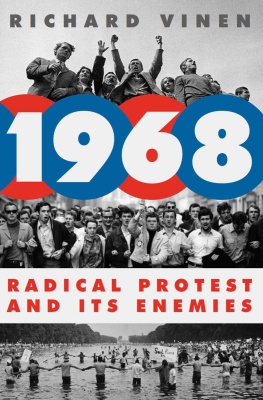MAKING GAY HISTORY
The Half-Century Fight for Lesbian and Gay Equal Rights
ERIC MARCUS

For my grandmother May Sperling Marcus, a different kind of pioneer, who gives love beyond measuring. And for my uncle, Richard Marcus, editor extraordinaire. With much love.
When the dust settles and the pages of history are written, it will not be the angry defenders of intolerance who have made the difference. That reward will go to those who dared to step outside the safety of their privacy in order to expose and rout the prevailing prejudices.
John Shelby Spong, retired Episcopal bishop of the Diocese of Newark, New Jersey
CONTENTS
What I set out to do in Making Gay History is comparatively modest. Rather than attempt a comprehensive survey of the half-century fight for lesbian and gay equal rights in the United States, Im offering just a taste as told through the stories and recollections of more than sixty peoplefrom high-profile leaders to the little-known and largely forgotten men and women who contributed in ways big and small.
Early on, I was influenced by an essay on biography written by Lytton Strachey, the gay Bloomsbury writer, from the preface to his groundbreaking book, Eminent Victorians. He wrote:
It is not by the direct method of a scrupulous narration that the explorer of the past can hope to depict that singular epoch. If he is wise, he will adopt a subtler strategy. He will attack his subject in unexpected places; he will fall upon the flank, or the rear; he will shoot a sudden, revealing searchlight into obscure recesses, hitherto undivined. He will row out over that great ocean of material, and lower down into it, here and there, a little bucket, which will bring up to the light of day some characteristic specimen, from those far depths, to be examined with a careful curiosity.
Here and there I lowered my bucket into the rich, swirling waters of the gay rights movement. And what I found was astounding, heartbreaking, thrilling, and ultimately inspiring.
I hope that these few stories, this glimpse into the experiences of a relative handful of men and women, will bring to life a compelling and too often overlooked chapter of American history.
Just a brief note about this second edition of what was originally entitled Making History: It is a rare opportunity for a writer to revisit a book from early in his career and to make it new again. But thats the enormous opportunity Ive been given by my publisher, Cathy Hemming.
In the process of creating Making Gay History, Ive reorganized, rewritten, reedited, and judiciously pruned the original material, which was first published in 1992. And Ive added new material to cover the years through early 2001.
To help readers keep track of the more than sixty people I interviewed for this book, Ive included a list of the interviewees and brief descriptions of each person at the back of the book. Ive also included a glossary of acronyms and descriptions of the twelve cover photographs.

Chuck Rowland with his sister Mildred Reinhardt in 1943.
A T THE close of the nineteenth century, more than fifty years before the gay civil rights movement took root in the United States, the first organization for gay people, the Scientific Humanitarian Committee, was founded in Germany. The then-radical goals of the committee included the abolition of Germanys antigay laws and the promotion of public education about homosexuality. The committee also set out to encourage gay people to take up the struggle for their rights. The rise of the Nazis brought a brutal end to the Scientific Humanitarian Committee, and for decades after, Germanys gay civil rights movement would remain dormant.
In the United States, it wasnt until 1950 that the gay rights effort really got its start, with the founding of an organization called the Mattachine Society. But the stirrings began years before, and included the Society for Human Rights, a very short-lived gay rights organization founded by Henry Gerber in Chicago in 1924, and the Veterans Benevolent Association, a gay veterans social group founded in New York City in the 1940s.
The years immediately following World War II proved to be an especially fertile time for those gay men and women who dared to imagine that something could be done to improve the challenging conditions under which many of them lived. A handful did more than just imagine. Among them was a young man named Sam From, who was a student in one of psychologist Dr. Evelyn Hookers introductory night classes at UCLA in Los Angeles, California.
Dr. Evelyn Hooker
It became clear almost immediately that Sammy From was the most outstanding student in the class. He talked with me at intermission. He asked questions. There was just no doubt that he was the bright and shining star. You know, when a teacher finds a person like that, you fall for it hook, line, and sinker.
When Sammy discovered that I was taking the streetcar home after class, to save gasolinethis was during the warhe began driving me. Sammy had all the gasoline he wanted because he was writing million-dollar contracts between the Army Air Corps and the aircraft industry in this area. He had a high school education. His father was a junk dealer.
Our friendship developed gradually, but I had an idiotic policy then. I thought instructors should not fraternize with their students. It wasnt until he had finished my course that Sammy called me and asked if he could come over. We spent the evening talking. When he left, my husband Don turned to me and said, Well, you told me everything else about him, why didnt you tell me he was queer? I said, How could you possibly tell? Youre crazy! To which Don replied, He did everything but fly out the window.
Sammy was very eager to get to know us. He and his lover, Georgea much older man who was introduced as Sammys cousininvited us to dinner, and we went. (It was a delicious dinner.) They wanted my approval so much that they were afraid to let me know they were gay.
I dont remember a time when Sammy or George said, Were gay. They just gradually let down their hair and became very good friends of ours. They adored Don, who was very handsome, a marvelous talker. He was a sort of freelance writer in Hollywood and also worked on radio and did some painting. He liked them very much and wasnt bothered by the fact that they were gay. It wouldnt have occurred to him to be bothered by things like that because he had lived in Hollywood for a long time.
I didnt know much about homosexuality before I met Sammy, George, and their friends. As a matter of fact, when I was in college at the University of Colorado, The Well of Loneliness was circulating quietly. I remember reading it and thinking, Oh, gee. I wouldnt like to have to live my life with all that secrecy . But it has always made a lot of sense to me when gay people say, I had to have been born this way because almost from the very beginning of my sexual consciousness I was interested in men or I was interested in women. I was interested in men from the time I was an adolescent, and there was never any question about that. I think that that understanding, together with the rather extraordinary cross section of society into which I was introduced by Sammy, made the difference.
In 1945, after I had known them for about a year, Sam and George invited us to join them on a Thanksgiving holiday in San Francisco. We had an absolutely marvelous time. Sammy was one of these people I described as an if personality. If all the restraints were off, if he didnt have to behave like a businessman or a manager, then he was funny, funny, funny! He was dramatic and campy.

